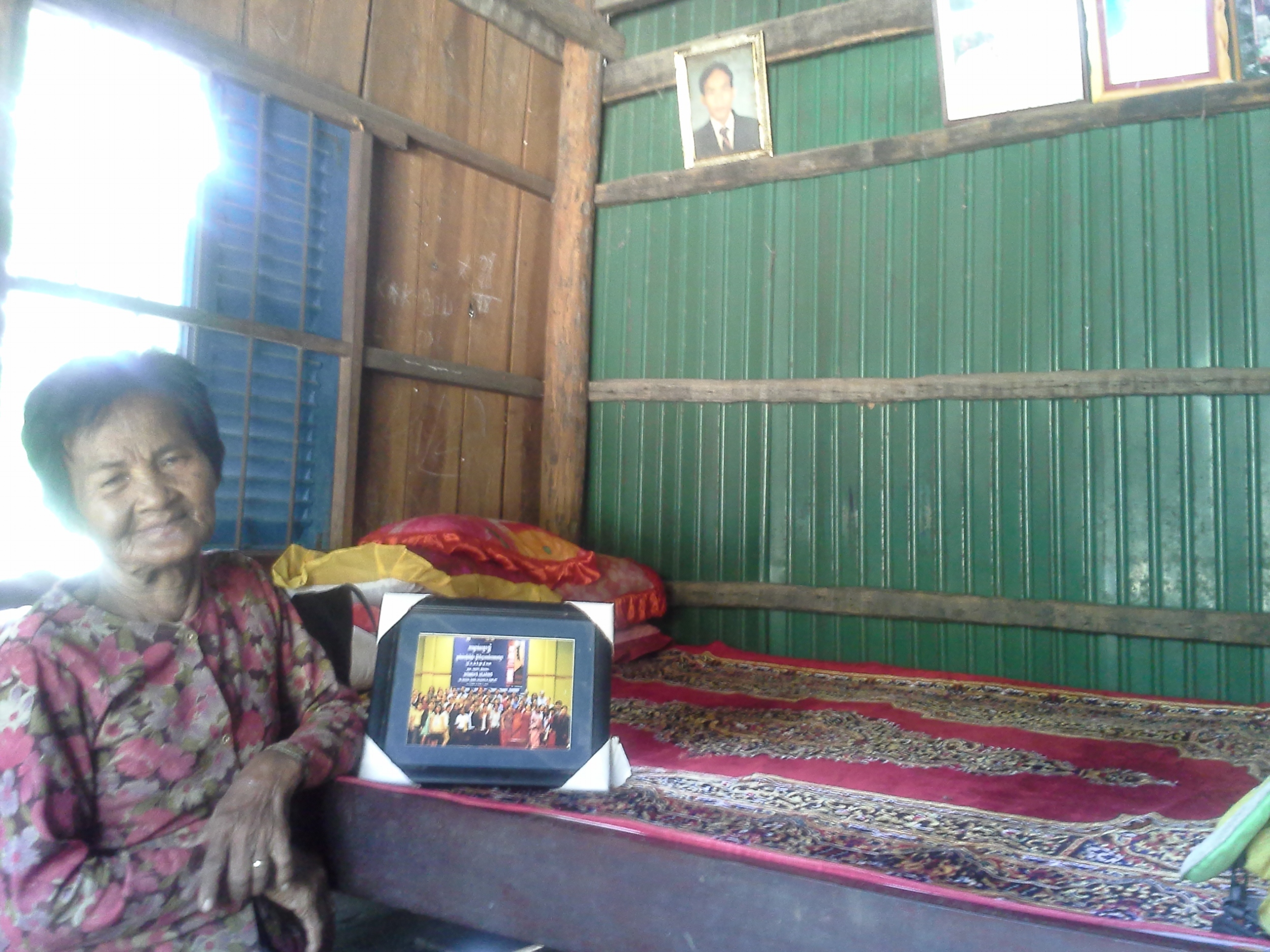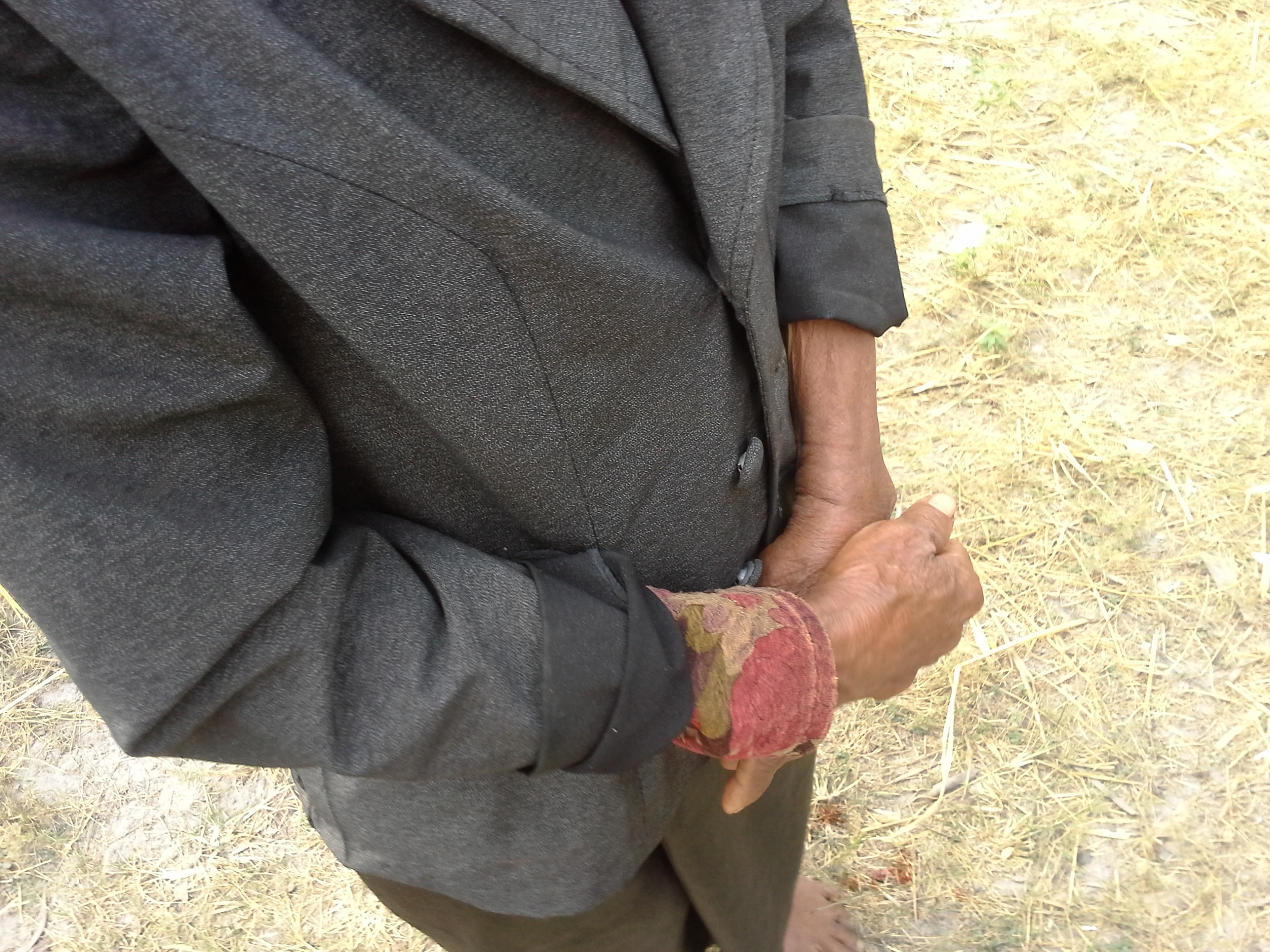Kim Khem, 80, Takeo, January 24, 2013
គឹម ខែម អាយុ ៨០ ឆ្នាំ រស់នៅខេត្តតាកែវ បានផ្តល់សក្ខីកម្មនៅថ្ងៃទី ២៤ ខែមករា ឆ្នាំ២០១៣
[See English Translation Below]
គឹម ខែម អាយុ ៨០ ឆ្នាំ រស់នៅខេត្តតាកែវ បានផ្តល់សក្ខីកម្មនៅថ្ងៃទី ២៤ ខែ មករា ឆ្នាំ២០១៣ ។
កំណត់ចំណាំ
បទសម្ភាសន៍នេះ ត្រូវបានរៀបចំឡើងដោយ លោកស្រីបណ្ឌិត ថេរីសា ឌីលែនហ្គីស ដែលជាអ្នកស្រាវជ្រាវឯករាជ្យ និង ជាអ្នកដឹកនាំក្នុងការសម្ភាសន៍នេះផងដែរ ។ កញ្ញា យូ សុធារី និង កញ្ញា ថន ស៊ីណា ជាជំនួយការរបស់គម្រោង ស្តីអំពីការនិយាយពីប្រវត្តិសាស្រ្ត ផ្ទាល់របស់ស្រ្តីកម្ពុជានេះ។ រក្សាសិទ្ធិគ្រប់យ៉ាង©២០១៣ អត្ថបទនេះនឹងមិនត្រូវបានអនុញ្ញាតឲ្យយកទៅប្រើប្រាស់ បោះផ្សាយ ឬ ថតចំលងដោយគ្មាន ការអនុញ្ញាតិ ពីអ្នកដឹកនាំការស្រាវជ្រាវ theresa.delangis@gmail.com ឬ(+៨៥៥ ១៧ ៥៣២ ៤១១) ឡើយ ។
“ការចម្លងអត្ថបទជាភាសារខ្មែរនេះ ត្រូវបានរៀបរៀងឡើងដោយ ម៉ា សាវីត ប្រែសម្រួលជាភាសា រអង់គ្លេស ដោយ ថន ស៊ីណា។ សូមថ្លែងអំណរគុណដល់ ចាយ បញ្ញាលក្ខណ៍ដែលជាអ្នកធ្វើការកត់ត្រា ជាភាសារ អង់គ្លេស ក្នុងពេល សម្ភាសន៍ និង ហ្វ្រែន ជែស្កាប៊ីនី ដែលជាអ្នកស្ម័គ្រចិត្តក្នុងការថតរូបក្នុងពេលសម្ភាសន៍ ។
នៅក្នុងសម័យខ្មែរក្រហម ការបង្ហាញនូវសេចក្តីស្រលាញ់ និង ភាពស្មោះត្រង់ ចំពោះសមាជិកគ្រួសារ និង ញាតិសន្តាន ត្រូវបានគេហាមប្រាមយ៉ាងតឹងតែង ។ រាល់ទង្វើ និង សកម្មភាពទាំងអស់ ត្រូវតែគោរពទៅតាម គោលការណ័បដិវត្តរបស់អង្គការតែប៉ុណ្ណោះ ។ អង្គការ គឺជាឈ្មោះអង្គភាពនយោបាយដែលមានឋានានុក្រម ខ្ពស់បំផុតនាសម័យខ្មែរក្រហម ។ ប្រសិនបើមានការបង្ហាញនូវអារម្មណ៍សប្បាយរីករាយ ឬ ទុក្ខសោក ឬ ភាពស្និទ្ធស្នាលណាមួយនោះរវាងសមាជិកក្នុងក្រុមគ្រួសារ នឹងត្រូវទទួលពិន័យ ឬ អាចឈានទៅដល់ការសម្លាប់ចោល ។ សមាជិកគ្រួសារត្រូវបានគេបំបែកទៅតាមអាយុ និង ភេទ ។ បុរស ស្រ្តី កុមារ និង មនុស្សចាស'ត្រូវបានគេបង្ខំឲ្យធ្វើការ និង ស្នាក់នៅក្នុងកងទីទៃពីគ្នា ។ កុមារតូចៗត្រូវបានបំពាក់បំប៉នថា “ឪពុកម្តាយបង្កើតរបស់គេមិនមែនជាឪពុកម្តាយរបស់ពួកគេឡើយ តែមានតែអង្គការប៉ុណ្ណោះដែលកុមារគ្រប់រូបត្រូវស្តាប់បង្គាប់ និង ត្រូវគោរពតាម ព្រោះអង្គការគឺជាឪពុកម្តាយថ្មីរបស់ពួកគេ” ។ នៅពេលដែលមានមនុស្សស្លាប់ សាកសពនោះត្រូវបានគេយកទៅចោលនៅក្នុងរណ្តៅរួម ។ ចំពោះសមមិត្ត ឬ ជាភាសាសាមញ្ញប្រែថាប្រជាជន ដែលទាមទារចង់រស់នៅជាមួយមនុស្សដែលពួកគេស្រលាញ់ នឹងត្រូវបានគេនាំទៅ “រៀន សូត្រ” មានន័យថា ដាក់ពិន័យ ឬ សម្លាប់ចោល ។
ប្តីរបស់លោកយាយ គឹម ខែម បានបាត់ខ្លួន ហើយ ទំនងជាត្រូវបានគេយកទៅសម្លាប់ក្នុងសម័យខ្មែរក្រហម ។ បន្ទាប់ពីក្រុមគ្រួសាររបស់គាត់ត្រូវបានគេជំលៀសឲ្យទៅរស់នៅតំបន់ជនបទក្នុងខេត្តតាកែវរួមមក លោកយាយ គឹម ខែម ក៏ត្រូវបានពួកខ្មែរក្រហមបំបែកពីកូនៗរបស់គាត់ទាំងអស់ លើកលែងតែកូនប្រុសតូចម្នាក់ដែលមានអាយុ១៣ ខែ ដែលត្រូវបានពួកវាអនុញ្ញាតឲ្យនៅជាមួយលោកយាយ ។ ថ្ងៃមួយ លោកយាយ គឹម ខែម បានដឹងពីដំណឹងមរណភាពរបស់ម្តាយគាត់ ។ ម្តាយរបស់លោកយាយ គឹម ខែម នៅធ្វើការនៅកងផ្សេងពីគាត់ ។ ដោយសារតែលោកយាយជាកូន ស្រីតែម្នាក់នៅក្នុងក្រុមគ្រួសារ គាត់ក៏បានសុំការអនុញ្ញាតិដើម្បីយកសាកសពម្តាយរបស់គាត់ទៅកប់ ទៅតាមទំនៀមទម្លាប់របស់ព្រះពុទ្ធសាសនា របស់ប្រជាពលរដ្ឋខ្មែរ ។ ប៉ុន្តែកម្មាភិបាលខ្មែរក្រហមបានបដិសេធចំពោះសំណើរបស់លោកយាយ គឹម ខែម និងបានប្រាប់គាត់ឲ្យចោលសពរបស់ម្តាយគាត់នៅក្នុងព្រៃ ។ ប៉ុន្តែលោកយាយ គឺម ខែម នៅតែព្យាយាមបញ្ចុះបញ្ចូលខ្មែរក្រហមឲ្យអនុញ្ញាតិឲ្យគាត់រក្សាទុកសាកសពរបស់ម្តាយគាត់ ដើម្បីរងចាំបងប្អូន និង កូនរបស់គាត់មកជុំគ្នាទើបយកទៅកប់ ។ បន្ទាប់ពីរៀបចំពិធីបុណ្យសពចប់គ្រប់សព្វហើយ លោកយាយ គឹម ខែម បានរៀបចំខ្លួនដើម្បីត្រលប់ទៅធ្វើការវិញ តែដោយសារពេលនោះយប់ជ្រៅពេក ទើបកូនៗរបស់លោកយាយ គឹម ខែម បានឃាត់ឲ្យគាត់ស្នាក់នៅទីនោះមួយយប់សិន ។ ជាអកុសល លុះដល់ពេលព្រឹកឡើង លោកយាយ គឹម ខែម ត្រូវបានគេចាប់ខ្លួននៅម៉ោង២ ដោយកម្មាភិបាលខ្មែរក្រហម ។ លោកយាយ គឹម ខែម បានទទូចសុំយកកូនគាត់ប្រុសតូចរបស់គាត់ដែលទើបតែមានអាយុ ១៣ ខែទៅក្នុងគុកជាមួយគ្នា ។ លោកយាយបានប្រាប់ពីរឿងរ៉ាវនៅយប់ដែលគាត់ត្រូវខ្មែរក្រហមចាប់ខ្លួន រួមទាំងការសម្លាប់កូនប្រុសរបស់គាត់ដ៍គួរឲ្យរន្ធត់ ដោយអ្នកយាមគុកខ្មែរក្រហម ។ នៅពេលដែលសួរទៅកាន់គាត់ថា តើមូលហេតុអ្វីពិតប្រាកដដែលគាត់ត្រូវគេចាប់ខ្លួន ? លោកយាយ គឹម ខែម បានឆ្លើយថា “គឺដោយសារតែលោកយាយនៅតែចចេសរៀបចំបុណ្យសពឲ្យម្តាយគាត់ដែលបានស្លាប់នោះ” ។ មកដល់បច្ចុប្បន្ន លោកយាយ គឹម ខែម នៅតែមានការតក់ស្លុត និង ឈឺចាប់ចំពោះហេតុការណ័ដែលបានកើតឡើងនេះ ហើយបទពិសោធន៍ជីវិតដ៍អាក្រក់នេះ តែងតែលងបន្លាចលោកយាយជានិច្ច ។ សព្វថ្ងៃនេះ លោកយាយពឹងផ្អែកទៅលើកូនរបស់គាត់ក្នុងការចំណាយលើថ្នាំសង្កូវរបស់គាត់់ ។
លោកយាយបានរៀបរាប់បន្តពីហេតុការណដែលបានកើតឡើងនៅពេលនោះ ។ លោកយាយបាននិយាយថានៅយប់នោះ គាត់មិនទាន់សំរាន្តផង ព្រោះទើបតែមកពីកប់សពម៉ែ ម៉្យាងទៀតលោកយាយនៅស្រណោះស្រណោកម្តាយលោកយាយ ទើបលោកយាយសំរាន្តមិនលក់ ។ លោកយាយគិតតែយំរហូត ស្រាប់តែគេមកហៅតែម្តង ។ គេបានបោកគាត់ថា គេមិនហៅគាត់យកទៅណាទេ កំុឲ្យគាត់បារម្ភ ព្រោះថាគេយកគាត់ទៅបើកស្ករ ។ នៅពេលដែលលោកយាយឮថាគេឲ្យគាត់ទៅបើកស្ករ គាត់សប្យាយចិត្តខ្លាំងណាស់ ព្រោះគាត់មិនដែលបានហូបអ្វីដែលមានជាតិស្ករយូរណាស់មកហើយ គាត់ក៍ប្រញាប់ប្រញាល់ទៅយកផ្តិលចាស់មួយ ដើម្បីដងទឹកយកមកលុបលាងមុខឲ្យស្អាត ។ បន្ទាប់ពីលុបលាងមុខរួចហើយ គាត់ក៏បើកទ្វារឲ្យគេចូល តែគេបែរជាចាប់ដៃគាត់ចងទៅក្រោយ ។ លោកយាយក៏បាននិយាយទៅកាន់ពួកគេថាកុំឲ្យចងគាត់ ព្រោះគាត់នឹងមិនអត់រត់ទៅណាទេ ព្រោះកូនរបស់គាត់កំពុងនៅដេក អត់មានអាវ អត់មានខោ ។ គាត់បានបន្តថា កូនទើបតែអាយុ ១៣ ខែ គ្មានខោអាវសម្រាប់ស្លៀកពាក់ឡើយ ។ គាត់ក៏អង្វរពួកគេឲ្យយកកូនតូចរបស់គាត់ទៅជាមួយផង ទោះជាពួកគេយកគាត់ទៅណា ក៏គាត់ព្រមទៅជាមួយពួកគេដែរ ព្រោះសព្វថ្ងៃនេះ គាត់គ្មានទីពឹងទេ កូនគាត់ដទៃទៀតក៍ក្លាយជាកូនរបស់អង្គការទាំងអស់ទៅហើយ ។ ឮដូចនេះ គេក៏ស្រាយអាហ្នឹងកន្សែងដែលគេចងដៃទៅគាត់ទៅក្រោយ យកមកពន្យួរកូនរបស់គាត់នៅហ្នឹងករបស់គាត់ ។ គេធ្វើដូចនេះដើម្បីឲ្យគាត់ និង កូនរបស់គាត់ស្លាប់ជាមួយគ្នា ។
សំនួរ៖ តើកន្សែងនោះនៅមានដល់ថ្ងៃនេះទៀតមែនទេ ?
គឹម ខែម៖ កន្សែងនោះអត់នៅមានទៀតទេ ។ កន្សែងហ្នឹងគេបានប្រើសម្រាប់ចងកូនរបស់គាត់ព្យួរទៅហ្នឹងករបស់គាត់ ។ បន្ទាប់មកគេកាប់ធាងត្នោតយកមកចងដៃរបស់គាត់ទៅក្រោយខ្នង ។ ធាងត្នោតនោះបានមុតសាច់របស់គាត់ ។ ពេលវាយកគាត់ទៅសម្លាប់ គាត់ភ័យខ្លាំងណាស់ គ្មានព្រលឹងទេ ។ គាត់ដើរចម្ងាយប្រហែលពីផ្ទះរបស់គាត់សព្វថ្ងៃទៅផ្សារ ក៏ឃើញមានគេយកមនុស្ស១១នាក់ទៀត ១២នាក់ទាំងគាត់ ទៅកាន់វាលដែលគេសម្លាប់នោះដែរ ។ ចំណែកកូនរបស់គាត់ដែលគេព្យួរនៅនឹងករបស់គាត់ វានៅតែដេកលក់ដដែល ។ នៅពេលដែលដើរទៅនោះ ពួកគេវាយត្រកៀកលោកយាយគ្មានឈប់ ធ្វើឲ្យលោកយាយឈឺក្តៅដូចភ្លើង សឹងតែដើរទៅមុខទៀតលែងរួច ។ ជើងរបស់លោកយាយមិនដឹងបោះជំហានទៅណាទេ ។ លុះនៅពេលដែលលោកយាយដើរលែងរួច គេគិតតែវាយលោកយាយដល់នាទីដែលគេសម្លាប់គាត់ចោល ។ វាលដែលគេយកលោកយាយទៅសម្លាប់នោះស្ថិតនៅភាគអាគ្នេយ៍នៅកណ្តាលព្រៃឡង់។ លោកយាយបានរៀបរាប់ពីទិដ្ឋភាពនៃទីវាលនោះថា មានដើមឈើធំៗណាស់ ។ ដើមឈើធំៗទាំងអស់នោះសុទ្ធតែជាសំបុករបស់សត្វឃ្មុំ ។ ឃ្មុុំទាំងអស់នោះវាកំពុងតែយកលម្អងផ្កា ធ្វើឲ្យឮសូរសម្លេងសន្ធឹក ។ នៅពេលដែលឃើញមានមនុស្សដើរទៅបានធ្វើឲ្យវាផ្អើលឡើង"អ៊ូ" ។ នៅទីនោះថែមទាំងមានក្លិនស្អុយខ្លាំងណាស់ ព្រោះវាមានសាកសពជាច្រើនមិនដឹងជាប៉ុន្មានលាននាក់ទេ ។ នៅកណ្តាលវាលព្រៃឈើនោះ គេជីករណ្តៅបួនជ្រុង មានជម្រៅប្រហែលពី ៥០ ម៉ែត្រ ទៅ១០០ ម៉ែត្រ សម្រាប់កប់ខ្មោច និយាយរួមទៅគឺវាវាយអ្នកដែលវាយកទៅសម្លាប់ទម្លាក់ក្នុងរណ្តៅនោះតែម្តង ។ នៅពេលដែលវាវាយស្លាប់ទៅ វានឹងទៅបោចស្លឹកឈើធំៗយកទៅគ្របពីលើខ្នងសាកសពនោះ ដើម្បីកុំឲ្យសាកសពហ្នឹងវាឡើងវាហើម និង កុំឲ្យមានក្លិនស្អុយខ្លាំងពេក ។ ហើយវាថាស៊ីសាគូស្ងោរទៅ អ្នកខ្លះស៊ីមាន់ដុតទៅ ហើយវាក៏វាយម្តងម្នាក់ៗនៅសល់តែលោកយាយម្នាក់ឯងគត់។ បន្ទាប់មកគេក៏និយាយថា យាយសំពត់ក្រហមចុះ!!! លោកយាយមិនដឹងចុះទៅណារួច ព្រោះអន្លុងនោះមានជម្រៅលិចក្បាលរបស់លោកយាយ ។ លោកយាយចុះបានតែបន្តិច គាត់មិនដឹងជាចុះទៅឯណាទៀត គាត់ក៏រអិលដួលផ្កាប់មុខ ធ្វើឲ្យកូនរបស់គាត់នៅពីក្រោម ចំណែកគាត់នៅពីលើ ។ នៅពេលដែលគេយាដំបងរកវាយគាត់ស្រាប់តែមានដើមឈឺមួយដើម វារលំមកសង្កត់លើលោកយាយ ធ្វើឲ្យគាត់សន្លប់បាត់ទៅ ។ គេស្មានថាគាត់ស្លាប់បាត់ហើយ គេក៏បោះដំបងចោលទៅ ដោយមិនវាយលោកយាយឡើយ ។ លោកយាយបានបន្តថាកន្លែងហ្នឹងហើយដែលជាកន្លែងដែលគាត់ស្លាប់ ហើយក៏ជាកន្លែងដែលគាត់បានរស់ឡើងវិញដែរ ។
លោកយាយក៏ហៅកូនរបស់គាត់ ហើយព្យាយាមចេញពីព្រៃស្រាប់តែបានជួបឈ្លប ។ គេក៏បានចាប់គាត់យកទៅឃុំ ដាក់ចងបីចំណងថែមទៀត ។ នៅកន្លែងនោះមានមនុស្សច្រើនណាស់ដែលត្រូវបានគេចាប់ឃុំខ្លួនដែរ សរុបទៅជាង៦០០ នាក់ ។ នៅទីនោះគេមិនឲ្យអាហារទៅឲ្យអ្នកណាបរិភោគទេ សូម្បីតែទឹកក៏មិនឲ្យផឹកដែរ ។ គេចងគាត់បានប្រាំពីរថ្ងៃ គេក៏ឲ្យគាត់ទៅច្រូតស្មៅឲ្យគោស៊ី ។ ក្មេងខ្លះត្រូវបានវាប្រើឲ្យទៅឃ្វាលគោ ។ ក្មេងទាំងនោះរើសលលាដូង រើសខ្យងខ្ចៅមកហូបទាំងឆៅ ។ ពេលវាហូបអស់ វាក៏នោម ហើយបបួលគ្នាផឹក ។ កូនរបស់គាត់វាឃ្លាន វាក៏ទៅផឹកទឹកនោមនោះនឹងគេដែរ ។ ស្ត្រីម្នាក់នៅក្បែរនោះដែលបានជាប់ឃុំជាមួយគាត់ដែរ បាននិយាយថា គាត់អាណិតដល់កូនរបស់លោកយាយខ្លាំងណាស់ ។ គាត់នឹងជួយស្រាយចំណងកូនរបស់លោកយាយចេញ ព្រោះគាត់មិនខ្លាចសេចក្តីស្លាប់ទៀតទេ ។ ប៉ុន្តែស្រាប់តែពេលនោះគេក៏យកស្រ្តីនោះទៅវាយចោលភ្លាម គឺថាគេយកគាត់វាយនៅមុខលោកយាយតែម្តង ដោយសារតែគាត់ចេះស្រាយចំណងនោះតាមចិត្តរបស់គាត់ដោយគ្មានការអនុញ្ញាតិ ។ ពេលដែលស្រ្តីនោះស្លាប់ទៅ គេក៏អូសគាត់ដាក់ខ្សែយកចេញទៅ ។ កូនរបស់គាត់នៅតែលិតទឹកនោមនោះទៀត ស្រាប់តែគេឡើងមក គេក៏ធាក់មាត់ទ្វារឮសូរតែប្រាវ ។ កូនរបស់គាត់ក៏ស្ទុះមកអោបជើងសំពត់របស់គាត់ដែលគាត់បានដាក់ខ្សែក្រវ៉ាត់ជាប់ ។ នៅពេលដែលកូនរបស់លោកយាយអោបជើងរបស់លោកយាយ គេក៏ចាប់កូនរបស់គាត់ផ្ងារ រួមយកស្បែកជើងកង់ឡានដែលវាពាក់មកជាន់កូនរបស់គាត់ ធ្វើឲ្យកូនតូចរបស់គាត់នោះលានអណ្តាតថ្លិន ។ លោកយាយបានយំអណ្តឺតអណ្តក ហើយបានបន្តទៀតថា កូនរបស់គាត់ក៏បានស្លាប់មួយរំពិចនោះតែម្តងទៅ ។ លោកយាយនៅតែបន្តយំស្រណោះកូនរបស់គាត់ដែលបានបាត់បង់ជីវិតនោះយ៉ាងឈឺចាប់ខ្លោចផ្សារ ។
***********
Kim Khem, 80, Takeo, January 24, 2013
NOTE: This interview was conducted by Theresa de Langis, Ph.D., lead researcher, and You Sotheary, Project Assistant, and Taing Samrach, student volunteer for English note taking during the interview. This interview is part of the Cambodian Women’s Oral History Project, ©2013, and is protected under Creative Commons copyright.
During the Khmer Rouge regime, family affection and loyalty was strictly prohibited, as all devotion was to focus on the revolutionary aims of Angkar,[i] the name the highest political body of the Khmer Rouge gave itself. Showing emotions such as happiness or sadness or expressing attachment to family members could lead to punishment or death. Family members were separated by age and gender, with men, women, children and the elderly working and living in different units. Children were told their parents were no longer their parents, and that their new "parent" was Angkar, who exacted total obedience. Religious rituals and traditional ceremonies to mark weddings, births and funerals were forbidden, and when people died they were often simply added by Khmer Rouge cadre to large mass graves. Those who resisted breaking the human ties with loved ones were "re-educated," punished or killed.
Kim Khem's husband was disappeared--and most likely killed--early during the Khmer Rouge regime. After the family was evacuated to the rural areas of Takeo, Kim Khem was separated from all of her children except the youngest, a 13-month-old son. One day, Kim Khem heard about the death of her mother on a separate work unit. Kim Khem, as the only daughter of her family, requested permission to provide her mother with a proper burial, which in Buddhist practice would entail cremation. Refused and told to simply throw the body away, Kim Khem convinced the cadre to allow her to travel to her children's work unit to at least bury her mother's body. Later that night after the funeral, she readied herself to travel back to her work unit, but her older children begged her to stay with them for the night. Overcome with mourning, she agreed. She was arrested at 2:00 a.m. by Khmer Rouge cadre. Refusing to abandon her youngest son, she insisted she bring him with her to the prison. Her excerpt details the night of her arrest and the weeks following, including the horrific murder of her son by a prison guard. When asked why she was arrested in the first place, Kim Khem replied, "for mourning the death of my mother." Today, Kim Khem still carries the scars of her ordeal, and she depends on her children's support for her considerable medical expenses.
I had not slept yet. . . . I missed and felt sorrow for my mother, so I could not sleep. Khmer Rouge cadres called me. They said, "Come with us and we will bring you to have some sugar." I had not seen sugar for years, so I hurried to grab an old bowl to clean my face. But it was a trick. I opened the door and they tied my hands behind my back with a scarf. I told them, "There is no need to tie me; I will not run. But if you take me away, please look at my baby who is sleeping naked and has no one to care for him. Please let me take him with me. I will follow you wherever you want. I have no husband or other family left, just this baby. My other children are not mine; they are now the children of Angkar. Let me take this baby with me." They untied my hands and used the scarf to tie my baby around my neck. They tied the baby around my neck. They wanted us to die together. . . .
They used the thorny stem of the sugar palm to tie my hands behind my back. The thorns cut into my flesh. They took me to the killing field, and I was afraid. I was shocked and without my senses; I was out of my body. We started to walk from the central area, where I joined 11 other women already waiting, and plus me was 12. As I walked, they beat me until it felt like hot fire. They beat me until I could barely walk, and I could not feel my legs. When we arrived at the killing field, I saw many big trees, the kind where the bees live. As the bees heard us approaching, they buzzed loudly, “Zzzzzz”. It smelled bad. I don’t know exactly how many people had died at this place. That killing field is southeast of Tierieng in the middle of Preyloer.
The cadres dug a square hole, maybe 50 or 100 meters. They used sticks and batons to beat the people on their heads, and the sound was like “phuoss…” When a person was dead, they’d kick the body into the pit and cover it with large tree branches [to prevent it from swelling up and smelling]. They would jeer at the people as they killed them, “You eat boil sago palm! You eat fried chicken!” Most of us were starving; it was very cruel. They killed 11 women by beating them with a stick until only I remained, the only one, the last one alive. They ordered me, “Grandma, you go down into the hole!” I didn't know how I could step down. The hole was deeper than I was tall. Then I fell into the hole face down, my baby under my body. Just then, a tree branch fell on top of me, and I lost consciousness. They thought for sure I was dead and walked away. I thought too that I had died. But I was still alive.
I climbed out of the grave and went to find my other children to get them out of that unit. But then a security guard found me, tied me in three places, arrested me and brought to the prison. My youngest son was still tied around my neck. The prison was so crowded; there were more than 600 people in that place. On the seventh day of being in the prison, with nothing to eat or drink, some children whose work it was to take care of the cows urinated in coconut shells and then drank their own urine. My baby was thirsty and cried when he saw the children drinking. One woman nearby noticed this and said, “I feel pity for your child. I will help you to untie your child from your neck. I am not afraid to die anymore.” She united the baby from my neck, and just then the cadre came in. They killed her. They killed her for untying my baby, and they dragged her body outside. My baby was thirsty; he crawled to the children and tried to drink the little urine that remained in coconut shell. He cried, “Wa…Wa…” The Khmer Rouge cadres heard my baby’s voice; they opened the door to the room. My baby saw them, and he crawled to me quickly. He tried to climb up my skirt, he held my legs, but he was too weak, and my arms were tied behind my back. The cadre caught my baby and stepped on his head with Kang Lan.[ii] They stepped on my baby’s head, making the sound “Krij” and my baby’s tongue was out of his mouth. [Cries] My baby died immediately. [Cries] My baby died immediately.
[i] Angkar, which literally means "Organization", referred to the highest political body of the Khmer Rouge regime.
[ii] The sandals worn by Khmer Rouge cadre, made from the rubber of old tires.
CLICK ON IMAGE FOR SLIDESHOW. Photos by Theresa de Langis (c) 2013. 1.) Kim Khem poses with a photo from the 2012 Asia-Pacific Women's Hearing on Sexual and Gender Based Violence in Conflict, where she provided public testimony; 2.) Photos of Kim Khem through the years on display in her house; 3.) The family pig, cared for but not slaughtered, according to the Buddhist way; 4.) Kim Khem's morning chores include feeding the animals; 5.) The outside kitchen; 6.) Kim Khem in front of the house she shares with her daughter; 7.) The family cows; 8.) Kim Khem's hands show a life of farming








